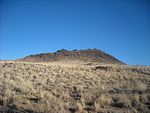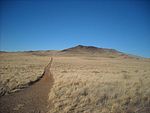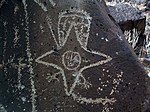Vulcan (inactive volcano)
Geography of Albuquerque, New MexicoInactive volcanoesLandforms of Bernalillo County, New MexicoPleistocene volcanoesQuaternary United States ... and 3 more
Stratovolcanoes of the United StatesVolcanoes of New MexicoVolcanoes of the United States

Vulcan, named after the Roman god of fire, is an inactive volcano on the West Mesa near Albuquerque, New Mexico. It is the largest of six volcanoes in the Albuquerque volcanic field within Petroglyph National Monument. Vulcan is a spatter cone volcano, formed primarily by lava fountains that were active in the central vent and in smaller vents on flanks of the cone. These flank vents formed the arches and caves seen today. It is believed to have last erupted around 150,000 years ago.
Excerpt from the Wikipedia article Vulcan (inactive volcano) (License: CC BY-SA 3.0, Authors, Images).Vulcan (inactive volcano)
Albuquerque
Geographical coordinates (GPS) Address Website Nearby Places Show on map
Geographical coordinates (GPS)
| Latitude | Longitude |
|---|---|
| N 35.141388888889 ° | E -106.77197222222 ° |
Address
Albuquerque (Αλμπουκέρκη)
Albuquerque
New Mexico, United States
Open on Google Maps







